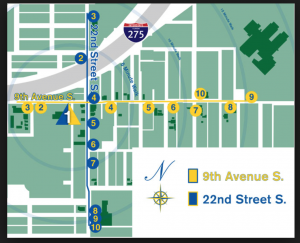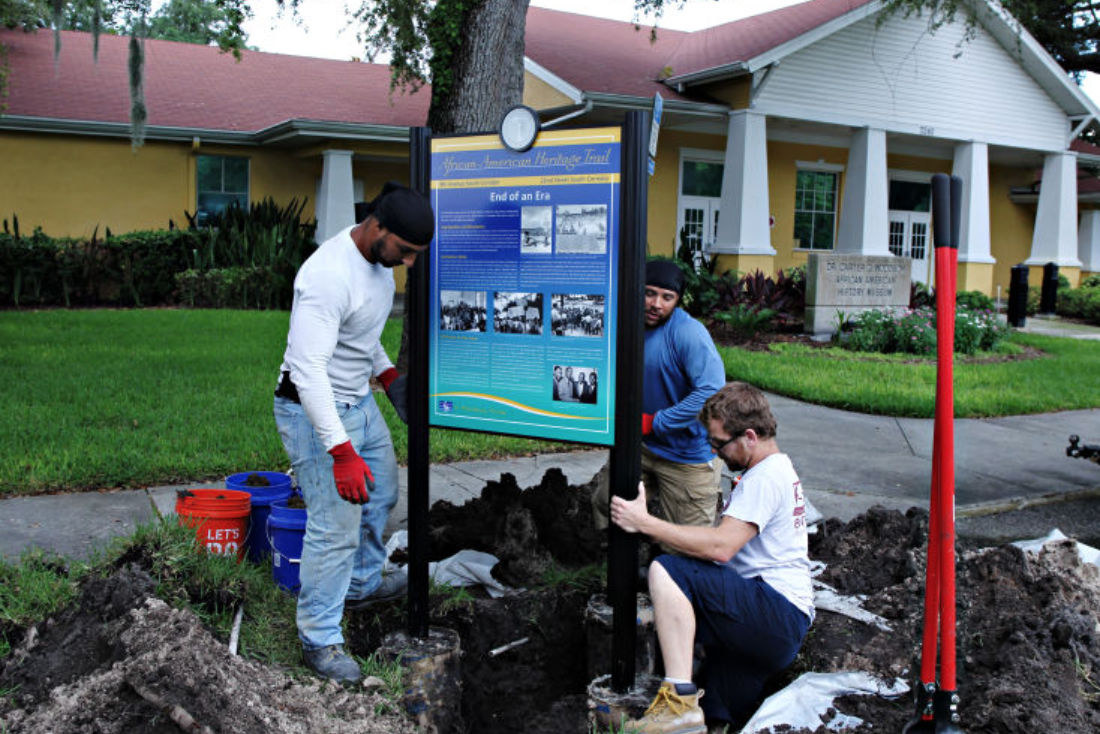BY RIM SHUMAN
NNB Reporter
ST. PETERSBURG – “Many people remember the 50’s and 60’s, but not a lot of people, especially not children, remember the times before it as well. So, I think that the boards are great to preserve information that could have been lost or forgotten in case they were not there,” said Kimberly Hinder, Historic Preservation Planner for the City of St. Petersburg.

This helped board members establish the themes for the corridor such as focusing on the commercial corridor with the African American businesses during segregation, Civil Rights, education and the role of family, clubs and religion.
“We had to gather the initial list of places and people through the advisory board meetings and public meetings but the detailed information on the boards was found through interviews and archival research.” said Hinder.
![The African American Heritage Trail Board titled End of an Era. [Photo Courtesy of StPete.Org]](http://www.nnbnews.com/wp-content/uploads/2015/09/Screen-Shot-2015-09-27-at-12.01.49-AM-300x211.png)
The grant could not be used for future maintenance, only initial development and installation, said Hinder.
“The boards are graffiti resistant and sun damage proof – we tried to get the best materials that last as long as it can possibly last for. The materials are the same materials that the National Park Service uses. The boards are warranted for ten years from the manufacturer so damage will be replaced if necessary,” said Hinder.
![David Mourra, from left, Steve Harris and Greg Keller place African American Heritage Trail Board in front of the Carter G. Woodson African American History Museum. [Photo Courtesy of Melissa Lyttle of Tampa Bay Times]](http://www.nnbnews.com/wp-content/uploads/2015/09/Screen-Shot-2015-09-26-at-11.57.12-PM-300x200.png)
The Trail received the Meritorious Achievement Award in 2015 for its preservational value.
The 20 detailed boards include background information and illustration of the African-American heritage that has flourished in the city of St. Petersburg; this attraction is a walking tour provided by the City of St. Petersburg in an area where black culture is embraced. They are placed in front of areas in Historic Midtown such as the Manhattan Casino, the Johnnie Ruth Clarke Center, formerly known as the Mercy Hospital, and the Royal Theater.
These boards are titled as the “Faith, Family and Education” on 9th Avenue which includes rich African-American heritage details that consist of the community, schools, organizations, religious centers and enrichment of the black society starting from the Jim Crow-era. There are approximately nine religious centers on this side of the trail, where the board focuses on such details of the now restored Jordan Elementary School.
![The Logo used for the African American Heritage Trail. [Photo Courtesy of Melissa Lyttle of Tampa Bay Times]](http://www.nnbnews.com/wp-content/uploads/2015/09/Screen-Shot-2015-09-26-at-11.59.38-PM-300x289.png)
The shops and places that are featured on these trail boards include information pertaining to the places where African-Americans couldn’t shop, sit, enjoy, contribute to or receive services during the time of racial segregation in America. These boards elaborate on iconic figures such as Louis Armstrong, Ray Charles and James Brown as their jazz music was a significant factor in placing a board in front of the Royal Theater and the Manhattan Casino.
The African American Heritage Association wants to found more boards though it will require another grant. There are many other sites in St. Petersburg that have potential for these markers including the South Mole, which served as a beach for African Americans in St. Petersburg; the Gas Plant, Pepper Town and Methodist Town.
“Little remains of these African American communities,” said Hinder.
If you go:
What: Keep Saint Petersburg Local 2nd Annual Localicious Eat Local Drink Local Week
When: Oct. 16- 25
Where: Downtown and Midtown St. Petersburg. Tours of the African American Heritage Trail are part of the event-filled week. For more information visit: http://keepsaintpetersburglocal.org/localicious.

